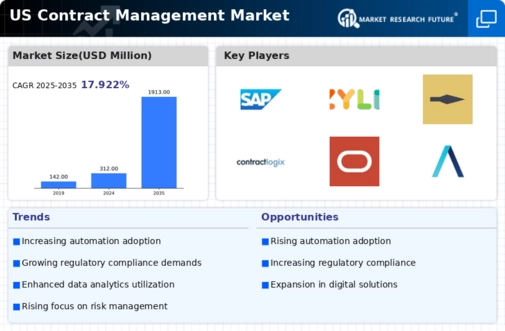Regulatory Compliance Pressures
In the contract management market, the pressures of regulatory compliance are intensifying. Organizations are compelled to adhere to a myriad of regulations, which necessitates robust contract management practices. The increasing complexity of legal requirements, particularly in industries such as finance and healthcare, drives the demand for sophisticated contract management solutions. Companies are investing in software that not only ensures compliance but also provides audit trails and reporting capabilities. This trend is underscored by the fact that non-compliance can lead to substantial financial penalties, with estimates suggesting that organizations could face fines exceeding $1 million for violations. Thus, the contract management market is positioned to grow as businesses seek to mitigate compliance risks.
Increased Focus on Risk Management
Risk management is becoming a central focus within the contract management market. Organizations are recognizing the importance of identifying and mitigating risks associated with contractual agreements. This heightened awareness is prompting businesses to adopt comprehensive contract management solutions that include risk assessment features. The ability to analyze potential risks and implement proactive measures is crucial in safeguarding organizational interests. As a result, the market is expected to see a rise in demand for tools that facilitate risk management, with projections indicating a potential market growth of 12% over the next few years. This trend underscores the evolving nature of contract management, where risk mitigation is integral to effective contract oversight.
Rising Demand for Digital Solutions
The contract management market is experiencing a notable surge in demand for digital solutions, driven by the need for efficiency and accuracy in contract handling. Organizations are increasingly adopting software that automates contract creation, tracking, and management. This shift is reflected in the market's projected growth rate, which is expected to reach approximately $2 billion by 2026. The integration of artificial intelligence and machine learning into contract management systems enhances decision-making processes, thereby reducing risks associated with manual errors. As businesses strive to streamline operations, the contract management market is likely to see a continued influx of investments in digital tools that facilitate better contract oversight and compliance.
Shift Towards Cloud-Based Solutions
The transition to cloud-based solutions is a significant driver in the contract management market. Organizations are increasingly recognizing the benefits of cloud technology, including enhanced accessibility, scalability, and cost-effectiveness. By utilizing cloud-based contract management systems, companies can streamline their processes and improve collaboration among stakeholders. This trend is evidenced by a reported increase in cloud adoption rates, with approximately 70% of businesses indicating a preference for cloud solutions over traditional on-premises systems. As remote work becomes more prevalent, the demand for cloud-based contract management tools is likely to continue to rise, further propelling market growth.
Focus on Data Analytics and Insights
The contract management market is witnessing a growing emphasis on data analytics and insights. Organizations are increasingly leveraging data to inform their contract strategies, enabling them to identify trends, optimize negotiations, and enhance overall performance. Advanced analytics tools provide valuable insights into contract performance metrics, which can lead to improved decision-making and risk management. This trend is particularly relevant as companies aim to maximize the value derived from their contracts. The market for analytics-driven contract management solutions is projected to expand, with estimates suggesting a growth rate of around 15% annually. Consequently, the integration of analytics into contract management practices is likely to shape the future landscape of the industry.

















Leave a Comment